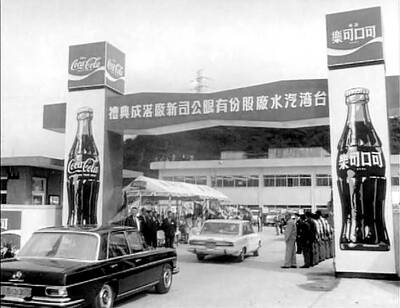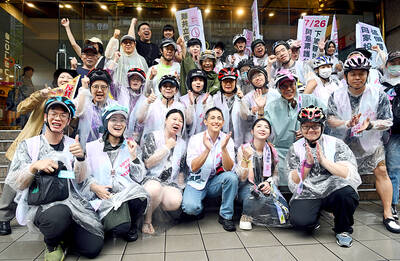The Hakka people make up a significant minority within Taiwan’s population and considerable efforts and money have been spent over the past few years to consolidate the group’s distinctive cultural identity. One of the biggest events for this purpose is the Taiwan Hakka Exposition (台灣客家博覽會) currently being held at the Taipei County Hakka Museum (台北縣客家文化園區) in Sansia (三峽). The event, which opened last month, runs until Feb. 15.
The exposition is a showcase of everything pertaining to the Hakka community and its culture around Taiwan. The ideological aspect of the event is clear from the moment you walk into the museum: the Hakka’s contribution to the making and prosperity of Taiwan.
Prominence has been given to the movie 1895 (一八九五), the recently released slipper-and-spear epic based on a novel by Li Chiao (李喬), one of Taiwan’s best-known Hakka writers, which tells the tale of a Hakka-led resistance movement after Qing Dynasty China ceded Taiwan to Japan after the First Sino-Japanese War. Unfortunately, as the display contains little more than the movie’s trailer run on a continuous loop and a few assorted items of traditional Hakka garb and objects that feature in the film, this is probably one of the least interesting parts of the expo. But the point is made, loud and clear: the Hakka were here from the beginning and are as much a part of the much talked-about “Taiwanese identity” as anyone else.
Far more interesting, and generally more lively, are the display areas for specialty products from well-known Hakka businesses and farmers’ associations across the country. For a person interested in getting an overview of Hakka cuisine in one afternoon, a visit to the expo is a good option, especially as many of the stands offer free tasting of their products.
With many of the farmers associations marketing natural high-end products, most visitors observed during a recent trip to the museum seemed far more interested in stocking up on artisan soy sauce, organic rice, handmade persimmon cakes and rice noodles than they were in checking out the historical and cultural exhibitions. Many celebrated Hakka restaurants have stands in the food court, offering such favorites as pickled cabbage soup and sticky rice cakes.
While the produce stalls and food court cater to the cardinal Taiwanese concerns of shopping and eating, the displays of Hakka history from their migration from China to the present day, are interesting if somewhat dry, with a preponderance of text-heavy information.
Exhibits about prominent Hakka personalities in Taiwanese and international affairs, explanations of Hakka religious practices and introductions to Taiwan’s main Hakka villages have to be read rather than looked at. More accessible is an exhibition of old photographs dating back to the Qing Dynasty that provide an insight into a Taiwan very different from the one we know today. From these historical displays, it is an interesting leap to look at the contemporary handicrafts and fashion that are being created to bring Hakka culture into the 21st century. A DIY center with a full program of activities gives visitors a chance to try their own hand at various handicrafts including making tea coasters and lei cha (擂茶), or pounded tea, a mixture of tea leaves, peanuts, mint leaves, sesame seeds, beans and herbs, which are ground into a powder and served as a drink.
The Hakka language also has a prominent place in the expo, with plenty of computer terminals loaded with teaching programs for children, and a book stand selling everything from dictionaries and colorful children’s books to academic studies of Hakka communities.
The expo includes a Hakka film festival, daily concerts and stage performances by Hakka artists, as well as a string of events highlighting Hakka practices for the Lunar New Year and Lantern Festival.
The event cost NT$100 million to set up and is certainly as comprehensive an introduction as you could want to Hakka culture. But despite the best efforts of a cadre of helpful and enthusiastic volunteer workers, it also bears all the hallmarks of an ideologically driven enterprise that fails to give sufficient attention to designing a satisfying user experience.

July 28 to Aug. 3 Former president Chiang Kai-shek (蔣介石) reportedly maintained a simple diet and preferred to drink warm water — but one indulgence he enjoyed was a banned drink: Coca-Cola. Although a Coca-Cola plant was built in Taiwan in 1957, It was only allowed to sell to the US military and other American agencies. However, Chiang’s aides recall procuring the soft drink at US military exchange stores, and there’s also records of the Presidential Office ordering in bulk from Hong Kong. By the 1960s, it wasn’t difficult for those with means or connections to obtain Coca-Cola from the

No one saw it coming. Everyone — including the Chinese Nationalist Party (KMT) — expected at least some of the recall campaigns against 24 of its lawmakers and Hsinchu Mayor Ann Kao (高虹安) to succeed. Underground gamblers reportedly expected between five and eight lawmakers to lose their jobs. All of this analysis made sense, but contained a fatal flaw. The record of the recall campaigns, the collapse of the KMT-led recalls, and polling data all pointed to enthusiastic high turnout in support of the recall campaigns, and that those against the recalls were unenthusiastic and far less likely to vote. That

Taiwan is today going to participate in a world-first experiment in democracy. Twenty-four Chinese Nationalist Party (KMT) lawmakers will face a recall vote, with the results determining if they keep their jobs. Some recalls look safe for the incumbents, other lawmakers appear heading for a fall and many could go either way. Predictions on the outcome vary widely, which is unsurprising — this is the first time worldwide a mass recall has ever been attempted at the national level. Even meteorologists are unclear what will happen. As this paper reported, the interactions between tropical storms Francisco and Com-May could lead to

A couple of weeks ago the parties aligned with the People’s Republic of China (PRC), the Chinese Nationalist Party (KMT) and the Taiwan People’s Party (TPP), voted in the legislature to eliminate the subsidy that enables Taiwan Power Co (Taipower) to keep up with its burgeoning debt, and instead pay for universal cash handouts worth NT$10,000. The subsidy would have been NT$100 billion, while the cash handout had a budget of NT$235 billion. The bill mandates that the cash payments must be completed by Oct. 31 of this year. The changes were part of the overall NT$545 billion budget approved